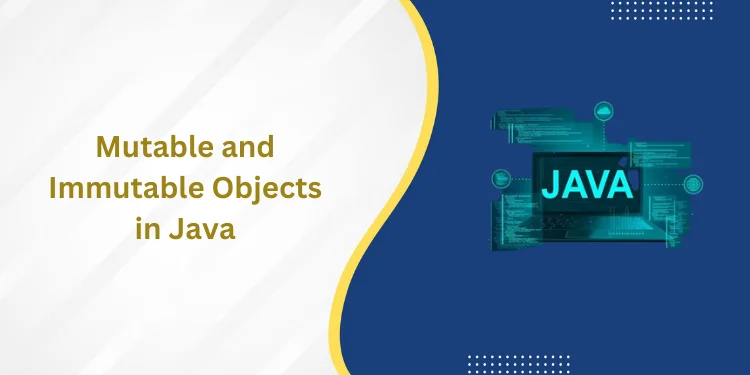Table of Contents
ToggleIntroduction
Mutable and immutable objects in Java, Mutable objects are those whose state can be changed after they have been created, while immutable objects are those whose state cannot be changed after they have been created.
Mutable objects are useful in situations where you need to modify the state of an object frequently, such as in a loop or when dealing with collections. Examples of mutable objects in Java include arrays, strings, and collections like ArrayList and HashMap.
On the other hand, immutable objects are useful in situations where you need to ensure that the state of an object remains constant, such as in multi-threaded environments where thread safety is important. Examples of immutable objects in Java include wrapper classes like Integer and Boolean, as well as String objects.
One of the key benefits of immutable objects is that they are inherently thread-safe, since their state cannot be changed after they are created. This can help prevent synchronization issues and race conditions in multi-threaded environments.
In summary, understanding the difference between mutable and immutable objects in Java is important for writing efficient and safe code. By choosing the right type of object for a given situation, you can help ensure that your coding is correct, efficient, and easy to maintain.
What are Mutable Objects and Why are they Important in Java?

In Java, mutable objects are those whose state can be changed after they have been created. This means that you can modify the values of the object’s fields or properties directly, and those changes will be reflected in the object’s state. Examples of mutable objects in Java include arrays, collections like ArrayList and HashMap, and custom classes that you create.
Mutable objects are important in Java for several reasons. mutable and immutable objects in java, one reason is that they allow you to create data structures that can be modified over time. For example, an ArrayList can be used to store a list of items that can be added to or removed from as needed. Another reason is that they can make it easier to write code that performs complex operations, since you can modify the state of an object to track the progress of the operation.
However, mutable objects also come with some drawbacks. mutable and immutable objects in java, One potential issue is that they can be more difficult to reason about, since their state can change over time. This can lead to bugs and other issues, especially in multi-threaded environments where multiple threads may be modifying the same object simultaneously. Another issue is that mutable objects can be less efficient than immutable objects in some cases, since modifying an object’s state requires allocating new memory and copying data.
Despite these drawbacks, mutable objects remain an important part of Java programming. They allow you to create complex data structures and perform complex operations, and they can be more flexible and efficient than immutable objects in some cases. structure of Java Program, However, it’s important to use mutable objects carefully and to understand the potential issues that can arise when working with them, particularly in multi-threaded environments.
Immutable Objects

In Java programming, immutable objects are objects that cannot be changed after they are created. Once an immutable object is created, its state cannot be modified, and any attempt to change its value will result in a new object being created. mutable and immutable objects in java, Examples of immutable objects in Java include String, Integer, and Double.
Immutable objects are important in Java programming for several reasons. Firstly, they are thread-safe, which means that they can be shared between multiple threads without any risk of race conditions or synchronization issues. This makes them ideal for use in concurrent programming.
Secondly, immutable objects are more secure than mutable objects because they cannot be modified once they are created. mutable and immutable objects in java, This means that any malicious code that tries to modify an immutable object will fail, reducing the risk of security vulnerabilities.
Finally, immutable objects are more predictable and easier to reason about than mutable objects. Because they cannot be modified, it is easier to reason about their behavior and predict how they will behave in different contexts. This makes them a valuable tool for building reliable and maintainable software systems.
In summary, immutable objects are an important concept in Java programming because they provide thread-safety, security, and predictability, making them a valuable tool for building reliable and maintainable software systems.
Understanding the Differences Between Mutable and Immutable Objects in Java
This is the most important topic while studying Java concepts. The topic asked in interviews mostly is “mutable and immutable objects in Java.”
In Java, an object is considered mutable if its state can be modified after it is created. Conversely, an object is considered immutable if its state cannot be modified once it is created.
Mutable objects can have their state changed through their methods or by directly modifying their properties. This means that if a mutable object is passed as an argument to a method, any changes made to the object within that method will also affect the original object. mutable and immutable objects in java, Examples of mutable objects in Java include ArrayList, HashMap, and StringBuilder.
On the other hand, immutable objects cannot have their state changed after they are created. This means that any method that appears to modify an immutable object actually returns a new object with the modified state. Examples of immutable objects in Java include String, Integer, and LocalDate.
The differences between mutable and immutable objects in java have several implications for programming. Mutable objects are generally used when the state of an object needs to be frequently modified, whereas immutable objects are used when the state of an object should not be modified. Because immutable objects cannot be modified, they are inherently thread-safe and can be shared between multiple threads without the need for synchronization. Immutable objects also make code easier to reason about because their behavior is more predictable.
In summary, the differences between mutable and immutable objects in Java boil down to their mutability. Among mutable and immutable objects in java immutable objects cannot be modified but mutable objects can be modified. Understanding these differences is crucial for writing efficient and bug-free code in Java.
Advantages and Disadvantages

Mutable and immutable objects in Java have their own set of advantages and disadvantages. Here are some of them:
Advantages of Mutable Objects
- Mutable objects allow for changes in their state, making them flexible and adaptable
to dynamic situations. - They can be more efficient than immutable objects when dealing with large amounts of data, as they don’t require the creation of new objects when their state is modified.
- They can be used for in-place modifications, which can reduce memory usage and improve performance in certain situations.
Disadvantages of Mutable Objects
- Mutable objects are not inherently thread-safe, and special care needs to be taken to ensure that they are used correctly in concurrent programming.
- They can be less secure than immutable objects because they can be modified after creation, which may lead to unintended changes.
- They can be more difficult to reason about and debug, especially in larger codebases.
Advantages of Immutable Objects
- Immutable objects are inherently thread-safe and can be safely shared between multiple threads without the need for synchronization.
- They are more secure than mutable objects because their state cannot be modified after creation, reducing the risk of unintended changes.
- They are easier to reason about and debug because their behavior is more predictable.
Disadvantages of Immutable Objects
- Immutable objects are less flexible than mutable objects, as their state cannot be changed after creation.
- They can be less efficient than mutable objects when dealing with large amounts of data, as they require the creation of new objects when their state is modified.
- They may require more memory, as each modification to their state results in the creation of a new object.
In summary, choosing between mutable and immutable objects in Java depends on the specific use case and requirements of the program. While mutable objects offer more flexibility and efficiency in certain situations, immutable objects provide thread-safety, security, and predictability.
How to Create Immutable Objects in Java?

There are several ways in which we can create mutable and immutable objects in java. But here we will be discussing immutable objects specifically.
Creating immutable objects in Java involves several steps. Here is a general guide to creating immutable objects:
Declare the class as final: This prevents the class from being extended and modified by other classes.
Declare all properties as private final: This ensures that the properties cannot be modified once they are set, preventing unintended changes to the object’s state.
Provide getter methods for all properties: Getter methods provide read-only access to the object’s state, allowing other classes to access the properties without modifying them.
Ensure that any mutable properties are not exposed: If the object contains any mutable properties, ensure that they are not exposed through the getter methods. This prevents other classes from modifying the object’s state.
Use defensive copying when necessary: If the object contains references to mutable objects, use defensive copying to create a new copy of the object instead of directly referencing it. This ensures that the original object cannot be modified through the reference.
Ensure that the class is properly constructed: Immutable objects should be constructed in a way that ensures that their state cannot be modified after creation. This may involve initializing all properties in the constructor and avoiding any setters or other methods that modify the object’s state.
By following these steps, you can create immutable objects in Java that are thread-safe, secure, and easy to reason about.
How to Create Mutable Objects in Java?
Since, we have discussed immutable objects. The topic “mutable and immutable objects in Java” demands mutable object creation steps also.
Creating mutable objects in Java is relatively straightforward. Here are the general steps involved in creating mutable objects:
Declare the class: Create a class for the object you want to create.
Declare the properties: Declare the properties that the object will have. Unlike immutable objects, these properties should not be declared as final.
Create setter and getter methods: Create methods to set and get the values of the object’s properties. These methods should allow the properties to be modified after the object is created.
Implement other methods as needed: Depending on the requirements of the object, additional methods may be needed to modify its state or perform other actions.
Ensure thread safety: If the object will be used in a multi-threaded environment, ensure that it is thread-safe. This may involve using synchronization or other techniques to prevent race conditions.
Test the object: Once the object is created, test it to ensure that it behaves as expected and that its state can be modified as needed.
By following these steps, you can create mutable objects in Java that are flexible and adaptable to dynamic situations. However, it’s important to keep in mind the disadvantages of mutable objects, such as their potential for thread-safety issues and difficulty in debugging.
The Role of Mutability in Java’s Garbage Collection Mechanism
The mutability of objects in Java according to mutable and immutable objects in Java plays a critical role in the garbage collection mechanism. Garbage collection is the process by which the Java Virtual Machine (JVM) automatically frees memory that is no longer being used by the program. This process is important for preventing memory leaks and ensuring efficient use of system resources.
In general, mutable objects can be more challenging for the garbage collector to manage than immutable objects. This is because mutable objects may be modified and discarded many times during the execution of the program, which can create a large number of objects that need to be garbage collected. This can result in increased overhead and reduced performance.
However, modern garbage collection algorithms are designed to handle mutable objects efficiently. For example, the JVM’s garbage collector uses a mark-and-sweep algorithm that identifies and frees objects that are no longer being used by the program. mutable and immutable objects in java, This algorithm is designed to handle both mutable and immutable objects and can efficiently manage objects with complex lifecycles.
In summary, mutability is an important consideration when designing Java programs, but modern garbage collection algorithms are designed to handle mutable objects efficiently. By following best practices for object creation and management, such as using immutable objects where possible and minimizing the creation of unnecessary objects, developers can help ensure that their programs are both efficient and effective in managing memory.
Also Read About : Data Science in India
Best Practices for Using Mutable and Immutable Objects in Java Programming
Here are some best practices for using mutable and immutable objects in Java programming:
Prefer immutable objects among mutable and immutable objects in java where possible – If an object does not need to be modified after creation, make it immutable. This simplifies the object’s state and reduces the risk of bugs and race conditions caused by concurrent modification.
Minimize mutable state: If an object needs to be mutable, minimize the amount of mutable state it contains. This makes it easier to reason about the object’s behavior and reduces the risk of bugs caused by unintended state changes.
Use defensive copying: When mutable objects are passed between methods or classes, use defensive copying to create a new copy of the object instead of passing the original reference. This ensures that the original object cannot be modified unintentionally.
Synchronize access to shared mutable state: If multiple threads need to access and modify the same mutable state, synchronize access to the state to prevent race conditions and other concurrency issues.
Avoid exposing mutable state in public interfaces: If an object contains mutable state, avoid exposing it in public interfaces. Instead, use encapsulation to hide the state and provide controlled access to it through methods and other interfaces.
Test and debug carefully: When working with mutable objects, test and debug carefully to ensure that the object’s state is correct and that changes to the state do not cause unintended side effects.
By following these best practices, developers can create programs that are efficient, secure, and easy to maintain, regardless of whether they use mutable and immutable objects in Java.
Click on the link to know more about : Types of Inheritance in Java with Realtime Examples
Real-World Examples of Using Mutable and Immutable Objects in Java Applications
Here are some real-world examples of using mutable and immutable objects in Java applications:
Date and Time: In Java’s standard library, the java.time package includes both mutable and immutable objects in Java classes for representing dates and times. For example, the LocalDateTime class is mutable and can be modified using setter methods, while the LocalDate class is immutable and can only be created using a constructor.
Banking Systems: In banking systems, it is common to use immutable objects to represent financial transactions. This is because transactions should not be modified once they are created to ensure the accuracy and security of the transaction history.
Gaming Applications: In gaming applications, mutable objects are often used to represent game state, such as the position and health of characters. This allows the game state to be updated in real-time as the game progresses.
Caching Systems: In caching systems, mutable objects can be used to store cached data that may be updated periodically. For example, a cache of user information may be stored in a mutable object that is periodically updated to reflect changes to user profiles.
Database Applications: In database applications, immutable objects can be used to represent database records that should not be modified directly by application code. This helps ensure the integrity and security of the database by preventing unintended modifications.
In general, the choice between using mutable and immutable objects in Java depends on the requirements of the application and the specific use case. By understanding the advantages and disadvantages of each approach and following best practices for object creation and management, developers can create mutable and immutable objects in Java applications that are efficient, reliable, and secure.
Conclusion
In conclusion of mutable and immutable objects in Java, mutable objects can be changed after they are created, while immutable objects cannot be changed. Mutable objects can be useful for cases where you need to modify the object’s state, while immutable objects can be useful for cases where you want to ensure that an object’s state cannot be modified after creation.
Both mutable and immutable objects in java have their own advantages and disadvantages. Mutable objects have their advantages, such as allowing you to make changes to the object without needing to create a new object. However, they can also be a source of bugs if not used carefully, especially in multi-threaded applications.
On the other hand, immutable objects are thread-safe by nature, making them a good choice for cases where you need to share objects between threads. They are also generally more predictable and easier to reason about, which can lead to more reliable code.
Overall, choosing between mutable and immutable objects in java depends on the specific requirements of your application. Both types have their pros and cons, and it’s important to understand their differences and choose the appropriate one for each situation.
Frequently Asked Questions (FAQs)
What is the difference between a mutable and immutable object in Java?
Among mutable and immutable objects in Java, mutable objects can be changed after it is created, while an immutable object cannot be changed after it is created.
Why are immutable objects preferred among mutable and immutable objects in Java ?
Immutable objects are thread-safe by nature among mutable and immutable objects in Java, making them a good choice for cases where you need to share objects between threads. They are also generally more predictable and easier to reason about, which can lead to more reliable code.
What are some common examples of mutable objects in Java?
Examples of mutable objects in Java include arrays, lists, maps, and sets.
What are some common examples of immutable objects in Java?
Examples of immutable objects in Java include strings, wrapper classes (such as Integer and Boolean), and the LocalDate and LocalTime classes in the Java 8 Date/Time API.
Can a mutable object be converted to an immutable object in Java?
Yes, it is possible to create an immutable copy of a mutable object in Java. This can be done by creating new objects among any of the two, mutable and immutable objects in java with the same state as the original object, and making sure that the new object’s state cannot be changed after creation. This can be achieved by using techniques such as defensive copying or using the builder pattern.













